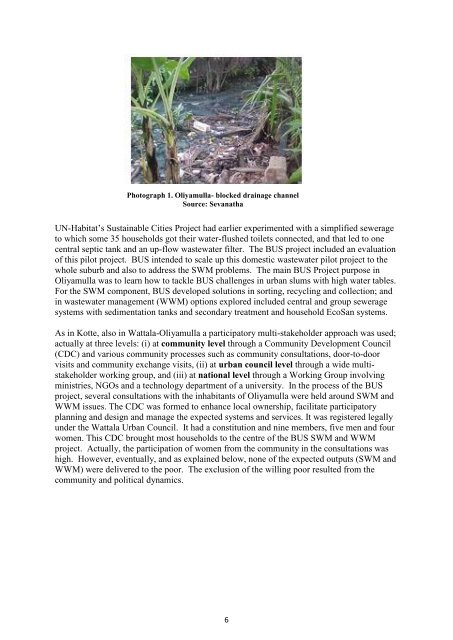Good practices for Social inclusion - Case studies and summary
Good practices for Social inclusion - Case studies and summary
Good practices for Social inclusion - Case studies and summary
You also want an ePaper? Increase the reach of your titles
YUMPU automatically turns print PDFs into web optimized ePapers that Google loves.
Photograph 1. Oliyamulla- blocked drainage channel<br />
Source: Sevanatha<br />
UN-Habitat‘s Sustainable Cities Project had earlier experimented with a simplified sewerage<br />
to which some 35 households got their water-flushed toilets connected, <strong>and</strong> that led to one<br />
central septic tank <strong>and</strong> an up-flow wastewater filter. The BUS project included an evaluation<br />
of this pilot project. BUS intended to scale up this domestic wastewater pilot project to the<br />
whole suburb <strong>and</strong> also to address the SWM problems. The main BUS Project purpose in<br />
Oliyamulla was to learn how to tackle BUS challenges in urban slums with high water tables.<br />
For the SWM component, BUS developed solutions in sorting, recycling <strong>and</strong> collection; <strong>and</strong><br />
in wastewater management (WWM) options explored included central <strong>and</strong> group sewerage<br />
systems with sedimentation tanks <strong>and</strong> secondary treatment <strong>and</strong> household EcoSan systems.<br />
As in Kotte, also in Wattala-Oliyamulla a participatory multi-stakeholder approach was used;<br />
actually at three levels: (i) at community level through a Community Development Council<br />
(CDC) <strong>and</strong> various community processes such as community consultations, door-to-door<br />
visits <strong>and</strong> community exchange visits, (ii) at urban council level through a wide multistakeholder<br />
working group, <strong>and</strong> (iii) at national level through a Working Group involving<br />
ministries, NGOs <strong>and</strong> a technology department of a university. In the process of the BUS<br />
project, several consultations with the inhabitants of Oliyamulla were held around SWM <strong>and</strong><br />
WWM issues. The CDC was <strong>for</strong>med to enhance local ownership, facilitate participatory<br />
planning <strong>and</strong> design <strong>and</strong> manage the expected systems <strong>and</strong> services. It was registered legally<br />
under the Wattala Urban Council. It had a constitution <strong>and</strong> nine members, five men <strong>and</strong> four<br />
women. This CDC brought most households to the centre of the BUS SWM <strong>and</strong> WWM<br />
project. Actually, the participation of women from the community in the consultations was<br />
high. However, eventually, <strong>and</strong> as explained below, none of the expected outputs (SWM <strong>and</strong><br />
WWM) were delivered to the poor. The exclusion of the willing poor resulted from the<br />
community <strong>and</strong> political dynamics.<br />
6

















